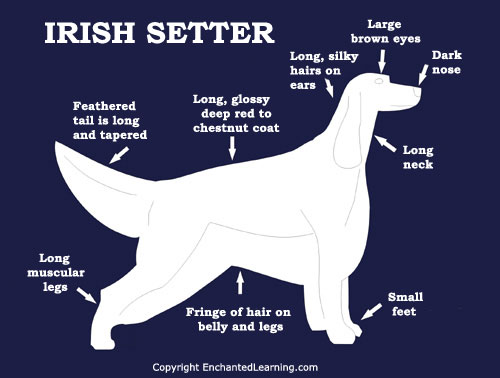IRISH
RED SETTER
ORIGIN: Ireland
UTILIZATION OF THE BREED: outstanding dog for hunting
Affectionate and loyal to the family.
CLASSIFICATION F.C.I.:
Group 7 (Pointing Dogs)
Section 2
(Pointers and Setters of Ireland & UK) With Working Trial.
BRIEF HISTORICAL SUMMARY:
The origins of the Red Irish Setter are relatively modern, though they date back to the beginnings of the XVIII century. Undoubtedly, these Setters gained popularity in Ireland in the XVIII century when they were trained to find the prey (Gun Dog). Although there was not a big number of dogs at the beginning of the XIX century, the breed was slowly gaining popularity. When The Irish Red Setter Club was established in Dublin in 1882, many people thought that this was the only Irish Setter. From this moment on, the Red Irish variety prospered, whereas the popularity of the Red and White variety diminished. Towards the end of the XIX century, the Red Setter was already being exported in great numbers and there were breeders of this variety outside Ireland. At present, it is as common in Great Britain, the rest of Europe and America as it is in Ireland. . Some owners started to consider the Setter more as a beautiful pet than as useful partners. Nevertheless, The Irish Club has been working to make sure that the Red Irish Setter can pass hard hunting field trials and the dog has proved to be more than a beautiful pet.
GENERAL APPEARANCE: full of life and athletic. In general terms, its appearance shows more spirit and character than strength and muscle.
TEMPERAMENT / BEHAVIOUR: owner of great qualities. Affectionate, aristocratic, lively and alert.
HEAD: long and lean, not coarse. It’s neither narrow nor pointed.
CRANIAL REGION:
SKULL: Oval (from ear to ear). Well defined occipital protuberance.
STOP: Well defined.
FACIAL REGION:
NOSE: The colour of the nose is dark mahogany, or dark walnut or black, the nostrils are wide.
MUZZLE: Moderately deep and fairly square at the end. From the stop to point of nose, long, flews not pendulous.
JAWS: They are strong and of nearly equal length. The upper lips are not pendulous.
Scissors bite.
EYES: Dark hazel or dark brown and of medium size.
EARS: Of moderate size, fine in texture, set low and well back, hanging in a neat fold close to head.
NECK:
Moderately long, very muscular, not too thick, slightly arched, no tendency to throatiness.
BODY:
Proportionate to the size of the dog.
SHOULDERS:
Fine at the point, deep and sloping well back
CHEST:
Deep chest, rather narrow in front, ribs well sprung, leaving plenty of lung room.
LOINS:
Muscular and slightly arched.
TAIL:
Moderate length, proportionate to size of body, set on rather low, strong at root, tapering to fine point. Carried level with or below back. It is allowed to carry the tail slightly upwards when the dog is on show, during work.
LIMBS
FOREQUARTERS
ELBOWS:
Free and well let down, not turned in or out.
FORELEGS:
Straight and sinewy, well boned.
HINDQUARTERS:
Wide and powerful.
Hindlegs
Long and muscular from hip to hock; from hock to heel short and strong.
STIFLE:
Well bent
HOCKS:
turned neither in or out
FEET:
Small, very firm, toes strong, arched and close together.
GAIT/MOVEMENT:
Free flowing, driving movement is preferable; the dog carries the head held high. Forelegs reaching well ahead but carried low. Hindquarters drive smoothly with great power. Crossing or weaving of legs unacceptable.
COAT-
HAIR:
On head, front of legs, and tips of ears, short and fine; on other parts of body and legs moderate length, flat and as free as possible from curl or wave. Feather on upper portion of ears long and silky; on back of fore and hind legs long and fine; fair amount of hair on belly, forming fringe which may extend onto chest and throat. Feet well feathered between toes. Tail having fringe of moderately long hair, decreasing in length as it approaches the point. All feathering straight and flat.
COLOUR
Rich chestnut with no trace of black; white on chest, throat, and toes; or small star on forehead or narrow streak or blaze on nose or face not to disqualify.
FAULTS:
Any departure from the foregoing points should be considered a fault and the seriousness of the fault should be in exact proportion to its degree.
|
